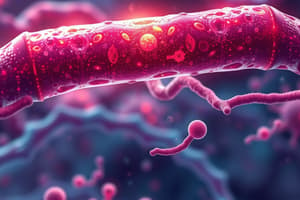Podcast
Questions and Answers
What role does GLUT1 play in glucose metabolism?
What role does GLUT1 play in glucose metabolism?
- It supplies glucose primarily to erythrocytes and brain endothelial cells. (correct)
- It transports fructose in the intestine.
- It facilitates glucose transport in muscle and adipose tissue.
- It regulates insulin levels in the pancreas.
Which statement is true regarding GLUT2?
Which statement is true regarding GLUT2?
- It transports monosaccharides from enterocytes into the bloodstream. (correct)
- It is expressed predominantly in muscle and adipose tissue.
- It has a high affinity for glucose.
- It does not respond to changes in blood glucose concentration.
The primary action of insulin on GLUT4 involves which process?
The primary action of insulin on GLUT4 involves which process?
- Degradation of GLUT4 in muscle cells.
- Translocation of GLUT4 to the plasma membrane. (correct)
- Synthesis of GLUT4 from amino acids.
- Inhibition of GLUT4 activity in liver cells.
Which GLUT transporter is primarily responsible for fructose transport?
Which GLUT transporter is primarily responsible for fructose transport?
GLUT3 has a predominant expression in which types of tissues?
GLUT3 has a predominant expression in which types of tissues?
Which condition is associated with GLUT1 deficiency syndrome?
Which condition is associated with GLUT1 deficiency syndrome?
What is the primary physiological function of GLUT4?
What is the primary physiological function of GLUT4?
Which organs are primarily involved in maintaining blood glucose concentration?
Which organs are primarily involved in maintaining blood glucose concentration?
What are carbohydrates primarily constructed from?
What are carbohydrates primarily constructed from?
Which type of carbohydrates contains more than 10 saccharide units?
Which type of carbohydrates contains more than 10 saccharide units?
What role do oligosaccharides play when conjugated to proteins and lipids on cell surfaces?
What role do oligosaccharides play when conjugated to proteins and lipids on cell surfaces?
What is the most abundant saccharide found in complex carbohydrates?
What is the most abundant saccharide found in complex carbohydrates?
Which of the following structures increases the surface area of the small intestine?
Which of the following structures increases the surface area of the small intestine?
What is the primary function of carbohydrates in the human diet?
What is the primary function of carbohydrates in the human diet?
Which component of the small intestine is responsible for nutrient transport from enterocytes?
Which component of the small intestine is responsible for nutrient transport from enterocytes?
How are carbohydrates classified based on their structure?
How are carbohydrates classified based on their structure?
What distinguishes liver glucokinase from muscle hexokinase in terms of feedback inhibition?
What distinguishes liver glucokinase from muscle hexokinase in terms of feedback inhibition?
In what metabolic state does muscle hexokinase typically operate at maximum velocity?
In what metabolic state does muscle hexokinase typically operate at maximum velocity?
How does glucose phosphorylation contribute to glucose entry into liver cells?
How does glucose phosphorylation contribute to glucose entry into liver cells?
What is the effect of insulin on glucokinase activity?
What is the effect of insulin on glucokinase activity?
What role does phosphoglucomutase play in glycogenesis?
What role does phosphoglucomutase play in glycogenesis?
What is the primary role of SGLT1 in enterocytes?
What is the primary role of SGLT1 in enterocytes?
Which glucose transporter is primarily involved in glucose uptake in the liver?
Which glucose transporter is primarily involved in glucose uptake in the liver?
What is a significant factor contributing to low glucokinase activity in individuals with type 1 diabetes?
What is a significant factor contributing to low glucokinase activity in individuals with type 1 diabetes?
Which of the following accurately describes the glucose transport mechanism of GLUT transporters?
Which of the following accurately describes the glucose transport mechanism of GLUT transporters?
What differentiates the Km values of muscle hexokinase and liver glucokinase?
What differentiates the Km values of muscle hexokinase and liver glucokinase?
What characterizes the distribution of SGLTs and GLUTs in the human body?
What characterizes the distribution of SGLTs and GLUTs in the human body?
What facilitates the initial entry of monosaccharides into the enterocytes?
What facilitates the initial entry of monosaccharides into the enterocytes?
Which GLUT transporter is known for allowing glucose to cross the blood-brain barrier?
Which GLUT transporter is known for allowing glucose to cross the blood-brain barrier?
What role does uridine triphosphate (UTP) play in glycogenesis?
What role does uridine triphosphate (UTP) play in glycogenesis?
How do SGLTs achieve transport of monosaccharides into cells?
How do SGLTs achieve transport of monosaccharides into cells?
Which enzyme is responsible for attaching UDP-glucose to the growing glycogen chain?
Which enzyme is responsible for attaching UDP-glucose to the growing glycogen chain?
What is the function of the branching enzyme in glycogenesis?
What is the function of the branching enzyme in glycogenesis?
Which statement best describes the cellular membrane's property in relation to molecule transport?
Which statement best describes the cellular membrane's property in relation to molecule transport?
What is the significance of the hepatic portal vein in relation to monosaccharide absorption?
What is the significance of the hepatic portal vein in relation to monosaccharide absorption?
What initiates the process of glycogenesis by forming a primer?
What initiates the process of glycogenesis by forming a primer?
What is the primary role of insulin in regulating blood glucose levels?
What is the primary role of insulin in regulating blood glucose levels?
How does insulin affect glycogen synthase?
How does insulin affect glycogen synthase?
What happens to glucagon secretion when blood glucose levels rise after a carbohydrate-rich meal?
What happens to glucagon secretion when blood glucose levels rise after a carbohydrate-rich meal?
What happens when glucose molecules are added to the glycogen chain?
What happens when glucose molecules are added to the glycogen chain?
What is a significant purpose of branching in glycogen structure?
What is a significant purpose of branching in glycogen structure?
How does insulin affect GLUT4?
How does insulin affect GLUT4?
Which pathway provides additional glucose for glycogen synthesis in the liver?
Which pathway provides additional glucose for glycogen synthesis in the liver?
Which process is primarily initiated by glucagon to increase blood glucose levels?
Which process is primarily initiated by glucagon to increase blood glucose levels?
What is the effect of glucocorticoid hormones on blood glucose levels?
What is the effect of glucocorticoid hormones on blood glucose levels?
In the case of insulin resistance, what typically happens to GLUT4 levels on the cell membrane?
In the case of insulin resistance, what typically happens to GLUT4 levels on the cell membrane?
Which of the following pathways does insulin primarily promote?
Which of the following pathways does insulin primarily promote?
The storage form of glucose in the body is primarily in the form of which molecule?
The storage form of glucose in the body is primarily in the form of which molecule?
Flashcards
Carbohydrates
Carbohydrates
Organic molecules primarily composed of carbon, hydrogen, and oxygen, structured like a hydrate of carbon (C‒H2O)n.
Monosaccharides
Monosaccharides
Simple sugars, like glucose and fructose, that cannot be broken down further.
Disaccharides
Disaccharides
Two monosaccharides linked together, like sucrose (table sugar) and lactose (milk sugar).
Complex carbohydrates
Complex carbohydrates
Signup and view all the flashcards
Oligosaccharides
Oligosaccharides
Signup and view all the flashcards
Polysaccharides
Polysaccharides
Signup and view all the flashcards
Folds of Kerckring
Folds of Kerckring
Signup and view all the flashcards
Villi
Villi
Signup and view all the flashcards
What is the brush border membrane?
What is the brush border membrane?
Signup and view all the flashcards
How many times do monosaccharides cross the enterocyte membrane?
How many times do monosaccharides cross the enterocyte membrane?
Signup and view all the flashcards
What is the basolateral membrane?
What is the basolateral membrane?
Signup and view all the flashcards
What are SGLTs?
What are SGLTs?
Signup and view all the flashcards
What are GLUTs?
What are GLUTs?
Signup and view all the flashcards
What is the structure of GLUTs?
What is the structure of GLUTs?
Signup and view all the flashcards
Where is SGLT1 found and what's its function?
Where is SGLT1 found and what's its function?
Signup and view all the flashcards
What is GLUT1 known for?
What is GLUT1 known for?
Signup and view all the flashcards
GLUT1
GLUT1
Signup and view all the flashcards
GLUT2
GLUT2
Signup and view all the flashcards
GLUT3
GLUT3
Signup and view all the flashcards
GLUT4
GLUT4
Signup and view all the flashcards
GLUT5
GLUT5
Signup and view all the flashcards
Blood glucose homeostasis
Blood glucose homeostasis
Signup and view all the flashcards
Ketogenic diet
Ketogenic diet
Signup and view all the flashcards
Ketone bodies
Ketone bodies
Signup and view all the flashcards
Blood glucose regulation
Blood glucose regulation
Signup and view all the flashcards
Insulin
Insulin
Signup and view all the flashcards
Glycogenesis
Glycogenesis
Signup and view all the flashcards
Glucagon
Glucagon
Signup and view all the flashcards
Glycogenolysis
Glycogenolysis
Signup and view all the flashcards
Gluconeogenesis
Gluconeogenesis
Signup and view all the flashcards
Insulin resistance
Insulin resistance
Signup and view all the flashcards
Why is muscle hexokinase efficient at normal glucose levels?
Why is muscle hexokinase efficient at normal glucose levels?
Signup and view all the flashcards
How does liver glucokinase differ from muscle hexokinase?
How does liver glucokinase differ from muscle hexokinase?
Signup and view all the flashcards
Why is glucokinase's higher Km important?
Why is glucokinase's higher Km important?
Signup and view all the flashcards
How does glucose phosphorylation enhance glucose uptake in the liver?
How does glucose phosphorylation enhance glucose uptake in the liver?
Signup and view all the flashcards
What role does GLUT2 play in liver glucose uptake?
What role does GLUT2 play in liver glucose uptake?
Signup and view all the flashcards
How is glucokinase regulated by insulin?
How is glucokinase regulated by insulin?
Signup and view all the flashcards
How does low insulin affect glucokinase in type 1 diabetes?
How does low insulin affect glucokinase in type 1 diabetes?
Signup and view all the flashcards
How does insulin resistance affect glucokinase in type 2 diabetes?
How does insulin resistance affect glucokinase in type 2 diabetes?
Signup and view all the flashcards
UDP-glucose pyrophosphorylase
UDP-glucose pyrophosphorylase
Signup and view all the flashcards
Glycogen synthase
Glycogen synthase
Signup and view all the flashcards
Glycogen primer
Glycogen primer
Signup and view all the flashcards
Branching enzyme (amylo(1-4→1-6)-transglycosylase)
Branching enzyme (amylo(1-4→1-6)-transglycosylase)
Signup and view all the flashcards
Active glycogen synthase (dephosphorylated)
Active glycogen synthase (dephosphorylated)
Signup and view all the flashcards
Less active glycogen synthase (phosphorylated)
Less active glycogen synthase (phosphorylated)
Signup and view all the flashcards
Study Notes
Carbohydrate Metabolism
- Carbohydrates are the most abundant organic molecules on Earth.
- They are the primary structural component of plants and a major source of food energy, often in the form of starch and sugars.
- Carbohydrates supply half or more of the world's food energy intake.
- Carbohydrates serve as metabolic intermediates, components of RNA and DNA, structural elements of cells and tissues, and energy storage molecules.
- Carbohydrate diversity arises from structural diversity.
- Chemically, carbohydrates approximate a “hydrate of carbon” (C-H₂O)ₙ.
Carbohydrate Structure
- Carbohydrates are categorized into simple and complex carbohydrates.
- Simple carbohydrates include monosaccharides (one sugar unit) and disaccharides (two sugar units).
- Complex carbohydrates include oligosaccharides (three to ten sugar units) and polysaccharides (more than ten sugar units, often thousands).
- Monosaccharides include glucose, fructose, and galactose.
- Disaccharides include sucrose, lactose, and maltose.
- Oligosaccharides include raffinose, stachyose, and verbascose.
- Polysaccharides include starch, glycogen, and dietary fiber.
Complex Carbohydrates
- Complex carbohydrates are polymers of saccharide units linked by glycosidic bonds.
- Oligosaccharides contain 3–10 saccharide units, while polysaccharides contain more than 10 (often thousands).
- Glucose is the most common type of saccharide in complex carbohydrates.
- Complex carbohydrates are a significant component of the human diet.
- Oligosaccharides are frequently conjugated to proteins and lipids in cells, acting as modulators of cell function.
Components of the Small Intestine
- The small intestine has several structural components that increase its surface area.
- Circular folds (folds of Kerckring), villi, and microvilli greatly increase the absorptive surface area.
- Villi are finger-like projections containing enterocytes (absorptive cells), blood capillaries, and lacteals (lymphatic vessels).
- Microvilli are hair-like extensions of the plasma membrane of enterocytes.
- The enterocyte membrane facing the lumen is called the brush border (or apical membrane).
Carbohydrate Absorption
- Dietary monosaccharides must cross the plasma membrane of enterocytes twice to enter the bloodstream.
- Monosaccharides first enter the cell on the brush border side and exit on the basolateral side.
- The basolateral side connects to capillaries of the hepatic portal vein; delivering the absorbed sugars to the liver for metabolic processes.
- The transport of molecules across cell membranes is closely regulated.
- Sodium-dependent glucose cotransporters (SGLTs) and facilitated diffusion glucose transporters (GLUTs) facilitate carbohydrate transport across membranes.
- Several GLUT types (GLUT1-7) have different regulatory properties and substrate specificities.
Blood Glucose Regulation
- Maintaining blood glucose levels is a vital homeostatic process that requires the concerted efforts of multiple organs (small intestine, liver, kidneys, etc.).
- Insulin and glucagon are important antagonistic pancreatic hormones that influence the control of blood glucose.
- Insulin lowers blood glucose levels, while glucagon raises them.
- Glucocorticoid hormones from the adrenal cortex also influence blood glucose levels.
- After eating, a rise in blood glucose triggers insulin release, causing GLUT4 translocation to the cell surface enabling glucose removal from the blood.
Glycogenesis
- Glycogenesis is the process of synthesizing glycogen.
- Glycogen is the storage form of glucose in muscle and liver, etc.
- Glucokinase in the liver and glucose-6-phosphate in the muscle are key enzymes in controlling glucose entry and metabolism.
- Glycogenesis needs ATP and UTP, consuming energy, but aids in blood glucose homeostasis.
- Glucose entering the liver is rapidly phosphorylated to glucose-6-phosphate, increasing glucose uptake.
Glycogenolysis
- Glycogenolysis is the breakdown of glycogen to glucose.
- Glycogen phosphorylase is the enzyme responsible for breaking down glycogen by cleaving alpha-1,4 glycosidic bonds.
- When glucose levels are high, glycogen synthase is inhibited for homeostasis.
- Additional enzymes remove glucose from branch points, called debranching enzyme, for later energy use.
- In muscle, glucose release is used as energy, while in liver it's for maintaining blood glucose levels.
Studying That Suits You
Use AI to generate personalized quizzes and flashcards to suit your learning preferences.



